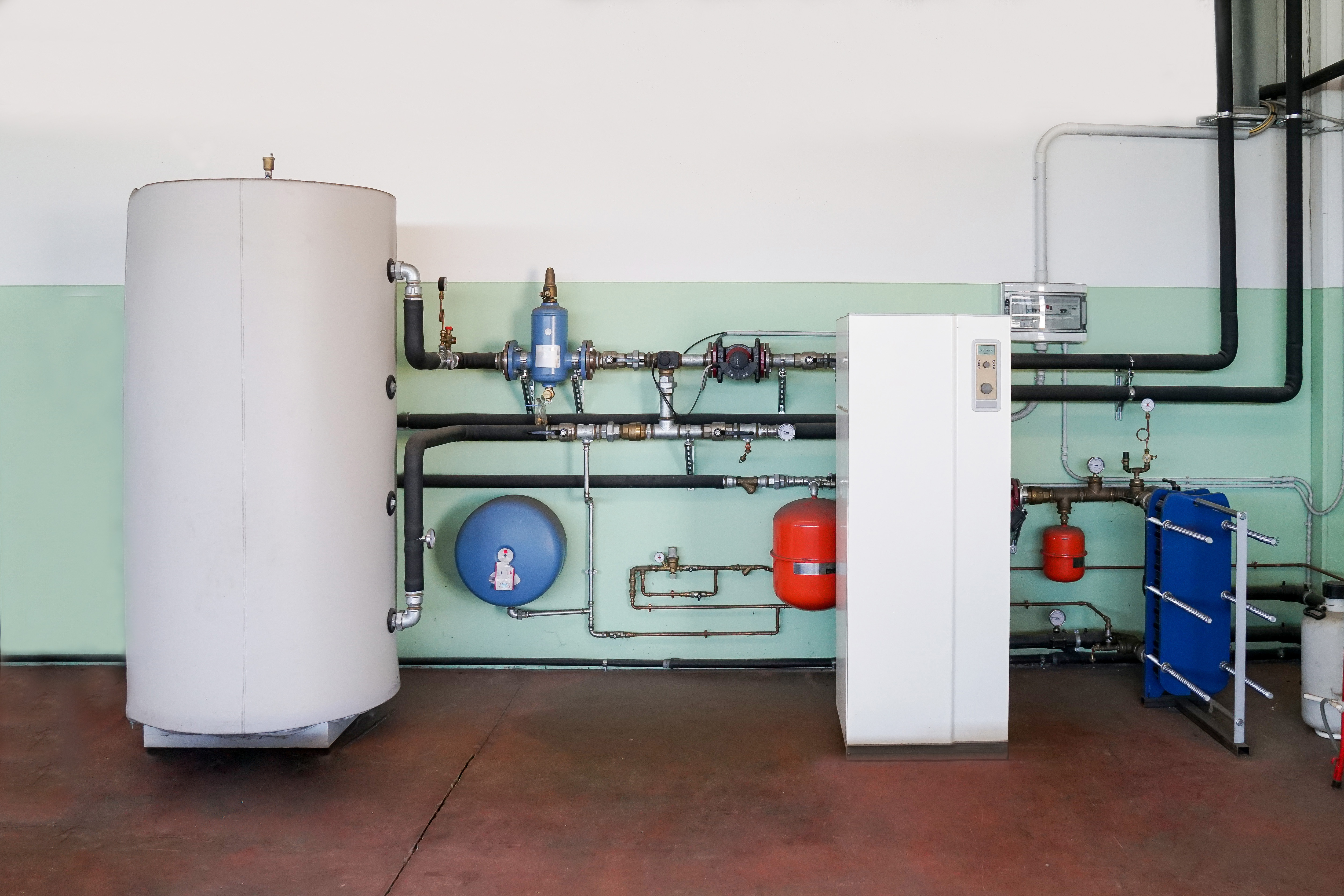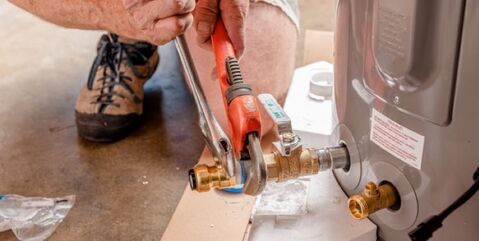A geothermal water heater diagram shows how a geothermal heat pump uses a compressor to heat your home and produce extra heat that is used to preheat your domestic hot water tank. The desuperheater harvests the extra heat and deposits it into your electric hot water tank.
Understanding Geothermal Water Heaters
A geothermal water heater diagram shows how a geothermal heat pump heats your home and preheats your hot water tank using extra heat produced by a compressor. The desuperheater transfers the heat to your electric hot water tank.
What Is A Geothermal Water Heater?
A geothermal water heater is a sustainable and energy-efficient alternative to traditional water heaters. It utilizes the heat from within the earth to heat your water, reducing your carbon footprint and lowering your energy costs. Geothermal water heaters work by using a geothermal heat pump to extract heat from the ground and transfer it to your water system.
Basics Of Geothermal Heating
Geothermal heating is a renewable heating technology that harnesses the natural heat energy stored within the earth. It operates on the principle that the ground temperature remains relatively stable throughout the year, making it an ideal heat source. The geothermal heat pump, the main component of the system, circulates a fluid through underground pipes called loops. As the fluid absorbs the earth’s heat, it transfers it to your home or water system through a heat exchanger.
Components Of A Geothermal System
A geothermal system consists of several components that work together to heat your water efficiently:
- Geothermal heat pump:
- Heat exchanger:
- Ground loops:
- Controller:
The geothermal heat pump is the heart of the system. It extracts the heat from the ground and transfers it to the water system. The heat pump uses a refrigerant to absorb and release heat, making it an efficient heat transfer device.
The heat exchanger is responsible for transferring the heat absorbed by the geothermal heat pump to your water system. It ensures that the heat is effectively transferred and utilized for water heating.
The ground loops are underground pipes that circulate a fluid, usually a mix of water and antifreeze, to absorb the earth’s heat. These loops are either buried horizontally or vertically, depending on the available space. Horizontal loops are commonly used for residential applications, while vertical loops are preferred for commercial buildings with limited ground space.
The controller is the brain of the geothermal system. It monitors and controls the operation of the heat pump, ensuring optimal performance and energy efficiency. The controller also allows you to adjust settings and monitor the system’s performance.
Understanding the components of a geothermal system is crucial for maximizing its performance and efficiency. By harnessing the earth’s natural heat, geothermal water heaters not only provide hot water but also contribute to a greener and more sustainable future.
Geothermal Water Heater Diagram Breakdown
A Geothermal Water Heater Diagram provides a visual representation of the various components and the flow of water and heat transfer within a geothermal water heating system. Understanding this diagram is crucial for homeowners and professionals alike, as it allows them to comprehend how the system works and troubleshoot any issues that may arise.
Annotating A Standard Geothermal Water Heater Diagram
To better understand a standard geothermal water heater diagram, let’s break it down component by component:
The Role Of Each Component Within The Diagram
Each component in the diagram plays a vital role in the functioning of the geothermal water heating system:
- Compressor: The compressor is responsible for pressurizing and circulating the refrigerant within the system.
- Condenser: The condenser transfers the heat from the refrigerant to the circulating water, thus heating it up.
- Evaporator: The evaporator absorbs heat from the surroundings and transfers it to the refrigerant.
- Desuperheater: The desuperheater utilizes the excess heat from the compressor to preheat the domestic hot water tank, increasing energy efficiency.
- Heat Exchanger: The heat exchanger facilitates the transfer of heat between the refrigerant and the circulating water.
- Pump: The pump is responsible for circulating the water throughout the system.
- Storage Tank: The storage tank holds the heated water, ready for usage.
Flow Of Water And Heat Transfer Illustrated
The geothermal water heater diagram illustrates how water flows through the system and how heat is transferred:
- The water enters the system through the intake pipe.
- It then passes through the heat exchanger, where it absorbs heat from the refrigerant.
- Next, the water moves into the storage tank, where it is stored at the desired temperature.
- When hot water is required, it is drawn from the storage tank and distributed for use.
- The cool water that returns from usage is then circulated back into the system through the pump.
- The heat transfer process repeats, ensuring a continuous supply of hot water.
Understanding the geothermal water heater diagram breakdown enables homeowners and professionals to identify any potential issues that may disrupt the flow of water or heat transfer within the system. Troubleshooting becomes more straightforward, allowing for prompt and efficient solutions.
Integration Of Geothermal Technology At Home
Geothermal technology has gained significant popularity in the recent years as a sustainable and cost-effective solution for heating and cooling homes. By harnessing the power of thermal energy from the ground, geothermal heat pumps provide efficient heating and cooling throughout the year. In this article, we will explore the integration of geothermal technology at home, discussing its applicability for residential versus commercial use, necessary modifications for installation, and space and environmental considerations.
Applicability For Residential Versus Commercial
Geothermal technology is applicable for both residential and commercial properties. However, the scale and complexity of the system may differ based on the size and usage of the building. Residential geothermal systems are typically smaller and cater to the heating and cooling needs of individual households. On the other hand, commercial geothermal systems are designed to serve larger spaces, such as office buildings or retail establishments.
Necessary Modifications For Installation
The installation of a geothermal heat pump requires certain modifications to the existing heating and cooling system of a home. These modifications include the following:
- Installation of a ground loop system: A ground loop system is buried underground and is responsible for extracting thermal energy from the earth. The type of ground loop system may vary based on factors such as available space and soil conditions.
- Integration with existing HVAC infrastructure: The geothermal heat pump needs to be seamlessly integrated with the existing HVAC infrastructure of the home. This includes connecting the heat pump with the ductwork and ensuring compatibility with the thermostat.
- Electrical and plumbing modifications: Electrical and plumbing modifications may be required to accommodate the geothermal heat pump. This may involve installing additional electrical circuits and making necessary changes to the plumbing system.
Space And Environmental Considerations
When integrating geothermal technology at home, space and environmental considerations play a crucial role. Here are a few key points to keep in mind:
- Space requirements: Geothermal systems require space for the installation of the ground loop system. The amount of space needed may vary depending on the size and configuration of the system. It is important to assess the available space on the property before proceeding with the installation.
- Environmental impact: Geothermal technology is known for its environmental benefits as it utilizes renewable energy from the ground. The use of geothermal heat pumps reduces carbon emissions and reliance on fossil fuels, making it an eco-friendly choice for homeowners.
- Noise considerations: Geothermal heat pumps operate with minimal noise compared to traditional heating and cooling systems. However, it is still important to consider the noise levels and ensure proper placement of the system to minimize any potential disruptions.
By carefully considering the applicability for residential versus commercial use, necessary modifications for installation, and space and environmental considerations, homeowners can successfully integrate geothermal technology into their homes, reaping the benefits of sustainable and efficient heating and cooling.
Diving Into The Mechanics
Understanding the inner workings of a geothermal water heater is essential to grasp the efficiency and benefits it offers. In this section, we will take a detailed look at the heat exchange process, examine the diagram’s representation of the closed-loop system, and explore the vital role of the desuperheater.
Detailed Look At The Heat Exchange Process
The heat exchange process is the heart of a geothermal water heater. It starts with a closed-loop system buried underground, where a mixture of water and antifreeze circulates through a network of pipes. This loop absorbs the constant, stable temperature of the earth, regardless of the external climate.
Once the loop collects the thermal energy, it is transferred to the heat pump located inside the building. The heat pump uses a compressor to increase the temperature of the collected thermal energy. This elevated temperature is utilized to meet the heating requirements of the building.
Simultaneously, the heat pump produces excess heat, which would usually go to waste. However, in a geothermal water heater, the desuperheater steps in to harness this surplus heat.
Diagram’s Representation Of The Closed-loop System
The diagram provides us with a visual representation of the closed-loop system, making it easier to understand the geothermal water heater’s functionality. It showcases the pipes buried beneath the ground, illustrating the network through which the water and antifreeze mixture flows.
Additionally, the diagram highlights the connection with the heat pump, emphasizing the transfer of collected thermal energy from the loop to the heat pump. Through this illustration, we can visualize the closed-loop system in action, enabling us to grasp its importance in harnessing the earth’s constant temperature.
Understanding The Desuperheater’s Role
The desuperheater plays a crucial role in maximizing the geothermal water heater’s efficiency. Its primary function is to capture and utilize the excess heat produced by the heat pump.
Within the closed-loop system, the desuperheater consists of a pump and a heat exchanger. It extracts the surplus heat from the heat pump and transfers it to the electric hot water tank. This process raises the temperature of the domestic hot water without any external energy input.
By utilizing the desuperheater, a geothermal water heater can provide not only space heating but also substantial savings in hot water production. This remarkable functionality sets it apart from traditional heating systems.
In conclusion, immersing ourselves in the mechanics of a geothermal water heater allows us to fully appreciate its energy-efficient operation. The heat exchange process, as well as the closed-loop system and the pivotal role of the desuperheater, ensures that this innovative technology maximizes energy utilization and provides sustainable heating solutions.
Advantages Of Geothermal Heating Systems
Geothermal heating systems offer numerous benefits that make them an attractive choice for homeowners. From energy efficiency to long-term cost savings and minimal maintenance requirements, these systems have a lot to offer. Let’s explore the advantages in more detail:
Efficiency And Environmental Impact
One of the main advantages of geothermal heating systems is their exceptional efficiency and minimal environmental impact. Unlike traditional heating systems that rely on fossil fuels, geothermal systems harness the natural heat stored within the earth to provide heating for homes.
This process involves using a series of underground pipes, called a geothermal loop, to extract heat from the ground and transfer it into the home. This method not only reduces greenhouse gas emissions but also minimizes the reliance on non-renewable energy sources.
Furthermore, geothermal heating systems have a high coefficient of performance (COP), typically ranging from 3 to 5. This means that for every unit of electricity used to power the system, it can produce three to five units of heat, making it significantly more efficient than conventional heating systems.
Long-term Cost Savings Analysis
Another significant advantage of geothermal heating systems is the potential for long-term cost savings. Although the initial installation cost may be higher compared to traditional heating systems, the energy savings can offset this expense over time.
According to studies, geothermal heating systems can reduce heating costs by up to 70% compared to other heating methods. This is because they harness the constant and stable heat from the ground, eliminating the need for expensive fuels or electricity for heating.
Additionally, many governments and utility companies offer incentives and tax credits for installing geothermal systems, further contributing to the cost savings. These financial benefits, combined with the energy efficiency of geothermal heating, make it a financially advantageous choice in the long run.
System’s Durability And Maintenance Needs
The durability and minimal maintenance requirements of geothermal heating systems add to their appeal. Unlike traditional heating systems that may require frequent repairs or part replacements, geothermal systems have fewer moving parts and are designed to last for decades.
The underground piping used in geothermal systems is made from durable materials such as high-density polyethylene (HDPE), which is resistant to corrosion and degradation. This ensures the longevity and reliability of the system, resulting in lower maintenance and repair costs.
Moreover, geothermal systems require minimal maintenance compared to traditional heating systems. Routine maintenance typically involves checking and cleaning the filters, inspecting the geothermal loop for leaks, and ensuring the proper functioning of the heat pump. With proper maintenance, geothermal heating systems can provide reliable and efficient heating for many years.
Overall, the advantages of geothermal heating systems, including their efficiency, cost savings, and durability, make them a viable and sustainable option for homeowners looking for an environmentally friendly and long-term solution for heating their homes.

Credit: www.energy.gov
Frequently Asked Questions On Geothermal Water Heater Diagram
How Does Geothermal Hot Water Heater Work?
A geothermal hot water heater works by using a geothermal heat pump to heat your home. The pump produces extra heat, which is used to preheat your domestic hot water tank. The extra heat is harvested using a pump and heat exchanger and deposited into your electric hot water tank.
How Hot Can Geothermal Water Temperatures Get?
Geothermal water temperatures can get very hot, depending on the location, and can reach high temperatures.
Why Is My Geothermal Hot Water Not Working?
If your geothermal hot water is not working, it may be due to an electrical problem. Check the fuse and other electrical connections for signs of wear. Insufficient water flow through the heat exchanger can also cause issues with your geothermal heat pump.
Troubleshooting Tips for Geothermal Heat Pump Problems: Sobieski Inc.
How Do You Pump Hot Water From Geothermal Resources?
Hot water is pumped from deep underground through a well under high pressure. This causes the pressure to drop when the water reaches the surface, allowing it to be used for various purposes.
Conclusion
A geothermal water heater system works by utilizing a geothermal heat pump to heat your home and produce excess heat. This excess heat is then used to preheat your domestic hot water tank through a process involving a desuperheater, pump, and heat exchanger.
With its efficient and sustainable design, geothermal water heaters offer an environmentally friendly solution to heating water. If you’re looking to reduce your carbon footprint and save on energy costs, a geothermal water heater is definitely worth considering.

I am a Water Heater specialist writer and blogger based in the USA & UK. I have been working with Water Heater for six long years. And I give trips on various Water Heater problems and solutions. I have a lot of experience with Water Heater And I share them here

